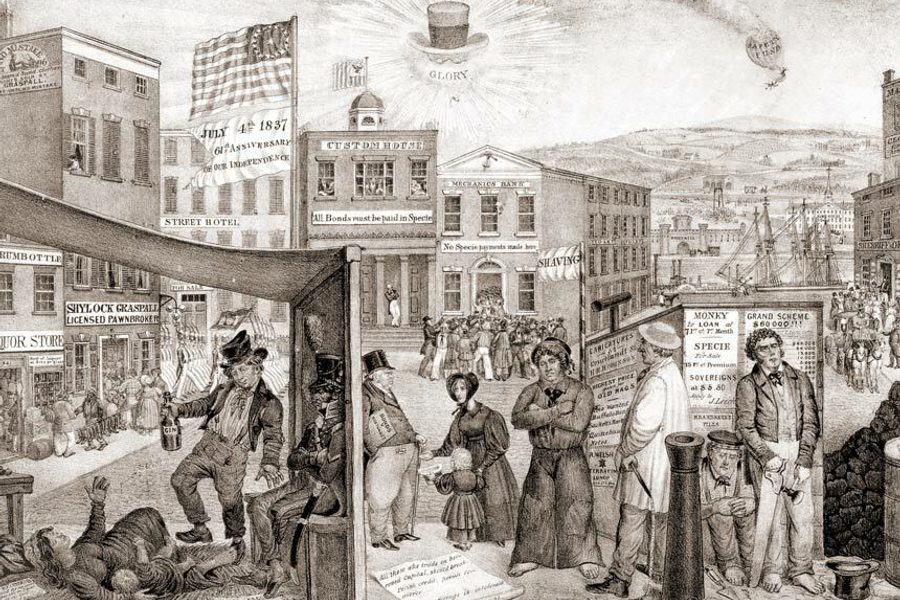Judginess Built the Middle Class
A new book explores the 19th-century origins of middle-class respectability—and the misfits kept out of the club.
Margaret Garb

“I have bought a map which is mistaken in all its details; I have bought a clock which did not go; I have bought a moth poison which the moths prefer to any other beverage; I have bought no end of useless inventions, and now I have had enough of this foolishness.”
So complained the writer Samuel Clemens (known as Mark Twain) in an 1876 issue of The Atlantic Monthly. Nineteenth-century magazines and the emerging penny press were full of such warnings of slick hucksters preying on respectable citizens. Clemens’ own creations, the charming tricksters Tom Sawyer and Huck Finn, were minor-league players in comparison. In a typical vignette, hucksters were accused of putting rotten fruit at the bottom of a basket.
Regardless of whether ordinary Americans were really besieged by dishonest peddlers, they made a convenient foil for honest businessmen. The apocryphal huckster was the alarming antithesis to the kind of respectability that bound together the 19th-century middle class and put a civilized gloss on American capitalism.
Hucksters are central to American Misfits and the Making of Middle-Class Respectability, Princeton sociologist Robert Wuthnow’s exploration of the shifting ways Americans have performed middle-class identity since its emergence in the mid-19th century. He finds that respectability has pertained less to keeping up with the Joneses than to keeping out the misfits.
Middle-class respectability arose alongside industrial capitalism in the United States. The qualities assigned to this mutable standard — hard work, perseverance, thrift, stable home-life and rationality — are the same as those attributed to good workers and reputable businessmen. Like middle-classness itself, respectability was relational, “a process of compare and contrast,” argues Wuthnow. Marginal people who did not conform to middle-class behaviors or achieve middle-class economic stability served as “the contrasting cases.” Hucksters — placeless, fast-talking and blithely unconcerned with the emerging rules of the free market — were measured against the plainspoken farmer, who, by contrast, sold goods at licensed stalls in weekly markets.
What’s fascinating here is not theories about “othering,” to which Wuthnow devotes much insufferable academic prose. So, skip the introduction and conclusion and jump into the beautifully researched case studies.
In a chapter on lunatics, for example, Wuthnow uses Civil War pension records to unravel the life story of William Hall, a Union Army veteran who was committed to an asylum in Topeka, Kansas. Mental illness was not well understood at the time, and stories circulated of community members losing their minds without warning. There was one report of a businessman who awoke one morning and slit the throats of his two children. Becoming a lunatic meant removal from one’s community. By 1874, 32 states had built asylums to house the insane.
Hall’s illness began during the war, and several years later he suffered a nervous breakdown. His physician delivered to the county court an affidavit declaring him incapable of managing his affairs, and a panel of 12 jurors concurred. Within a matter of days, Hall was sent to the asylum. His wife later received a $12 widow’s pension, but was unable to maintain the couple’s farm. The family dispersed, discredited by Hall’s illness.
Wuthnow’s crew of misfits also includes, surprisingly, the very religious and the very rich. Irrationality, whether expressed as insanity or religious fanaticism, stood in contrast to the beliefs and behaviors needed to sustain employment, pursue profit and work toward the American dream. Thus, religious fanatics who actively rejected the materialism of 19th-century market-oriented communities were portrayed as moral, but also excessively emotional and unreasonable. Meanwhile, the moneyed elite were labeled immoral, corrupt and undemocractic. The popular magazine, The Commoner, celebrated instead the “homey and wholesome, democratic and pure” common people.
All of Wuthnow’s misfits, in one way or another, threatened to undermine American capitalism by suggesting that some people could ignore its rules. By striving to remain respectable, above all else, the middle class has dutifully enforced those rules.








